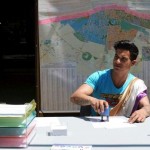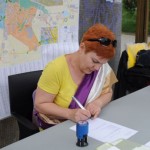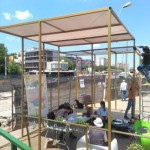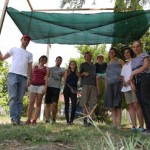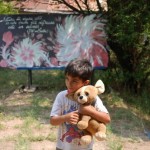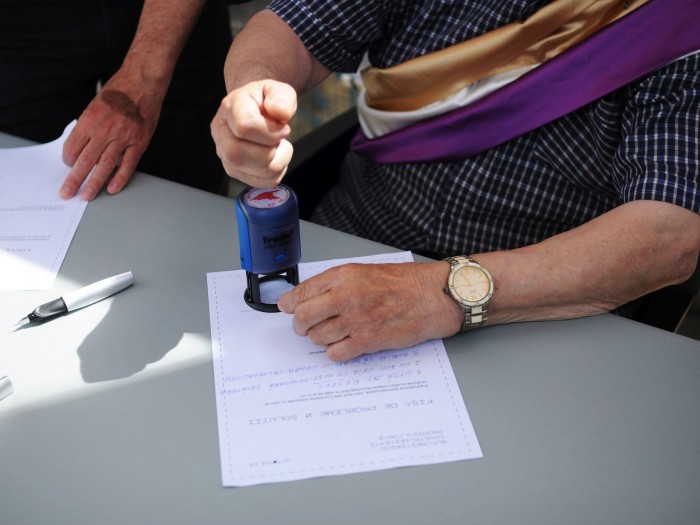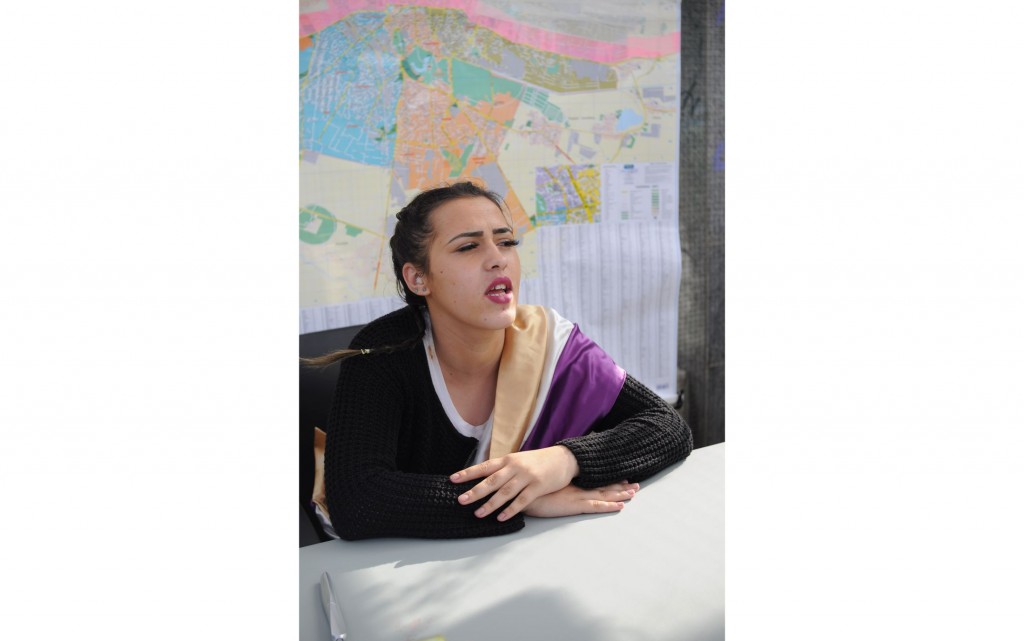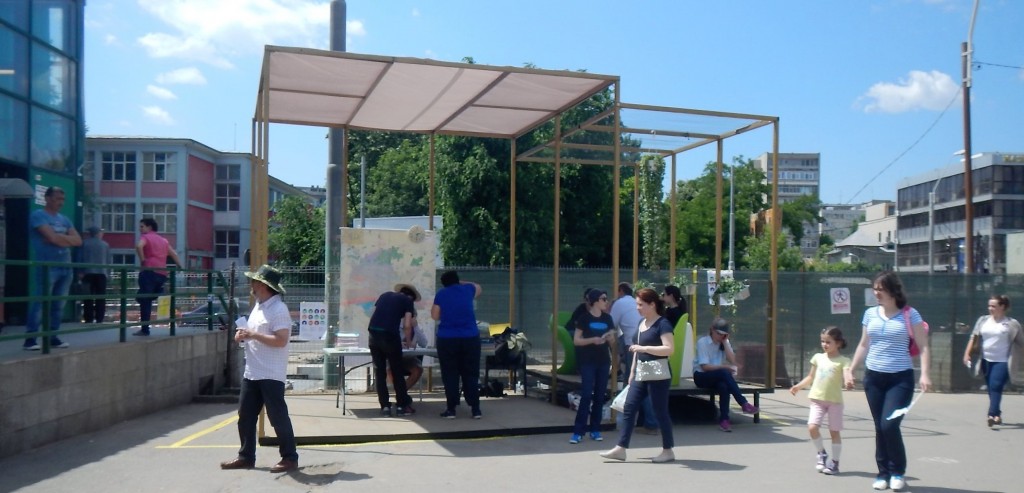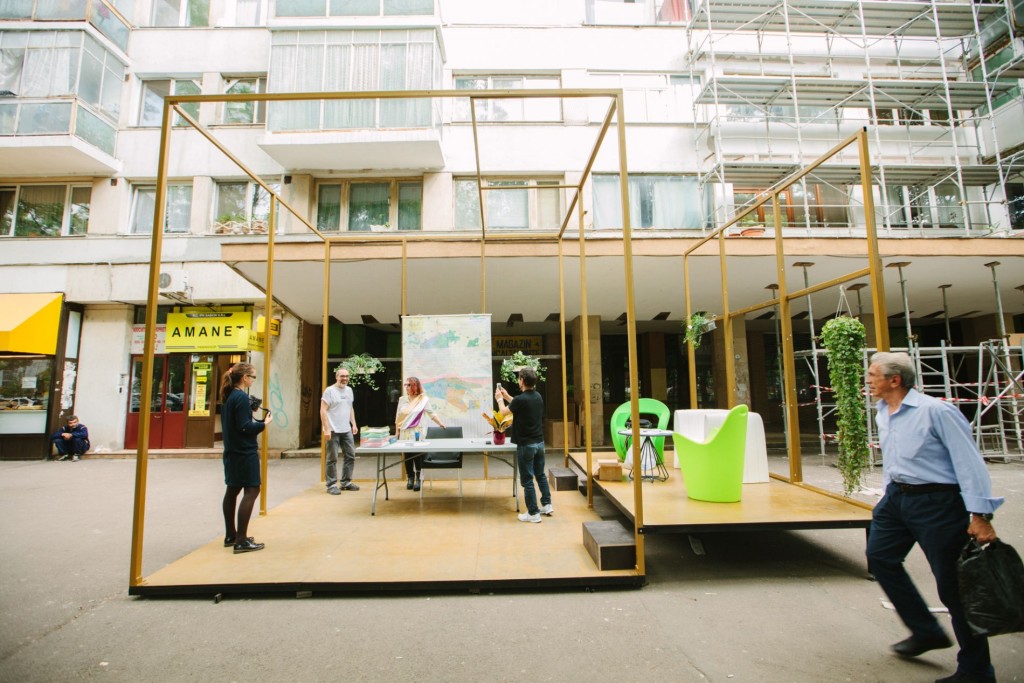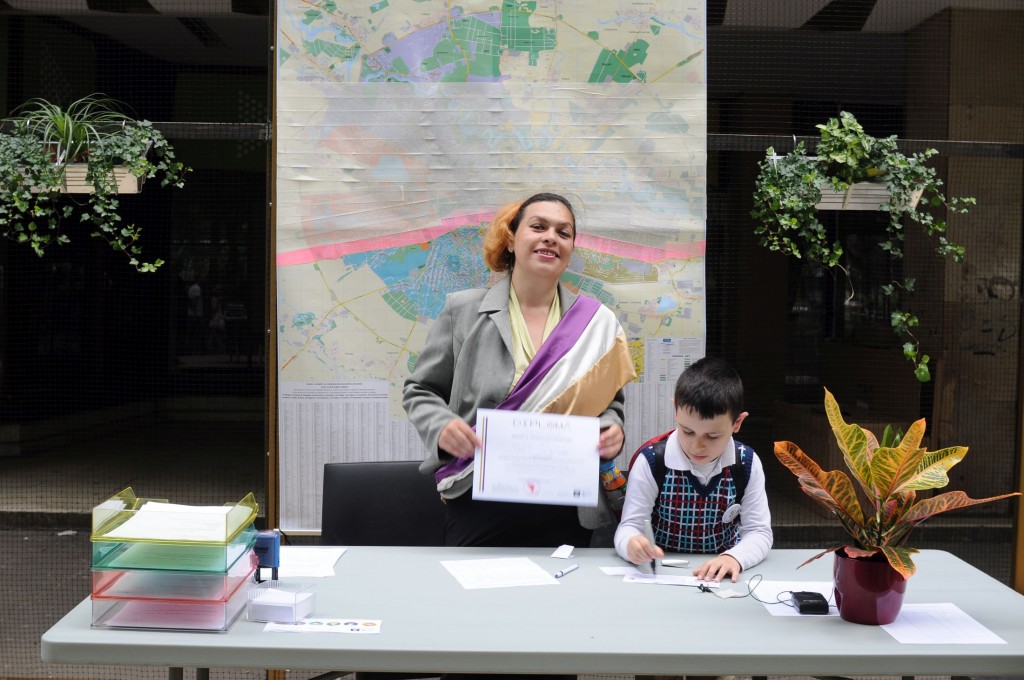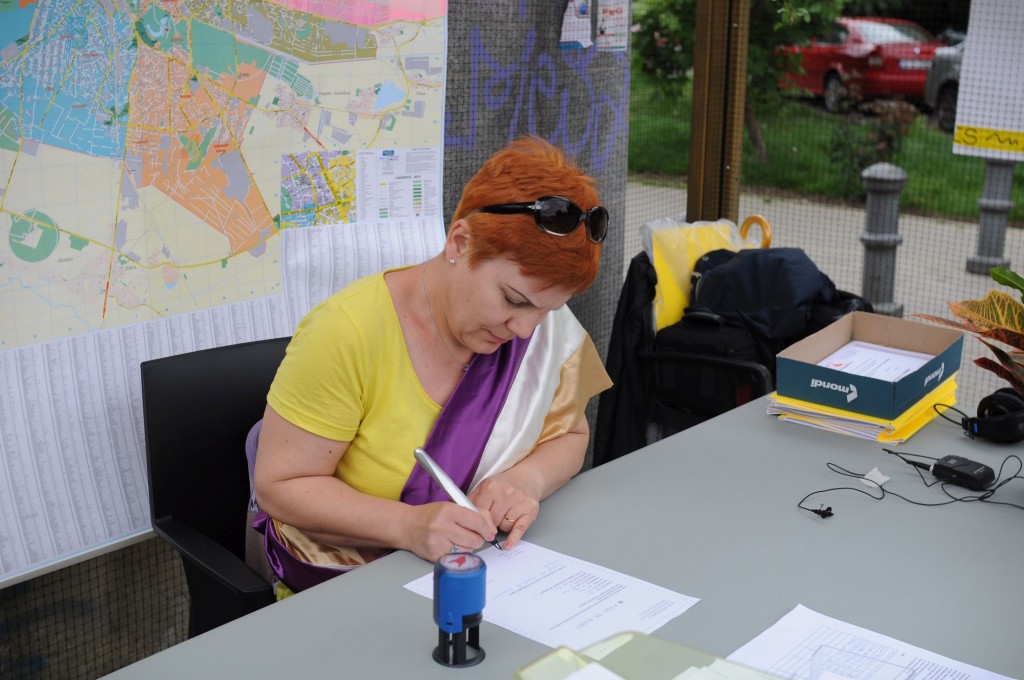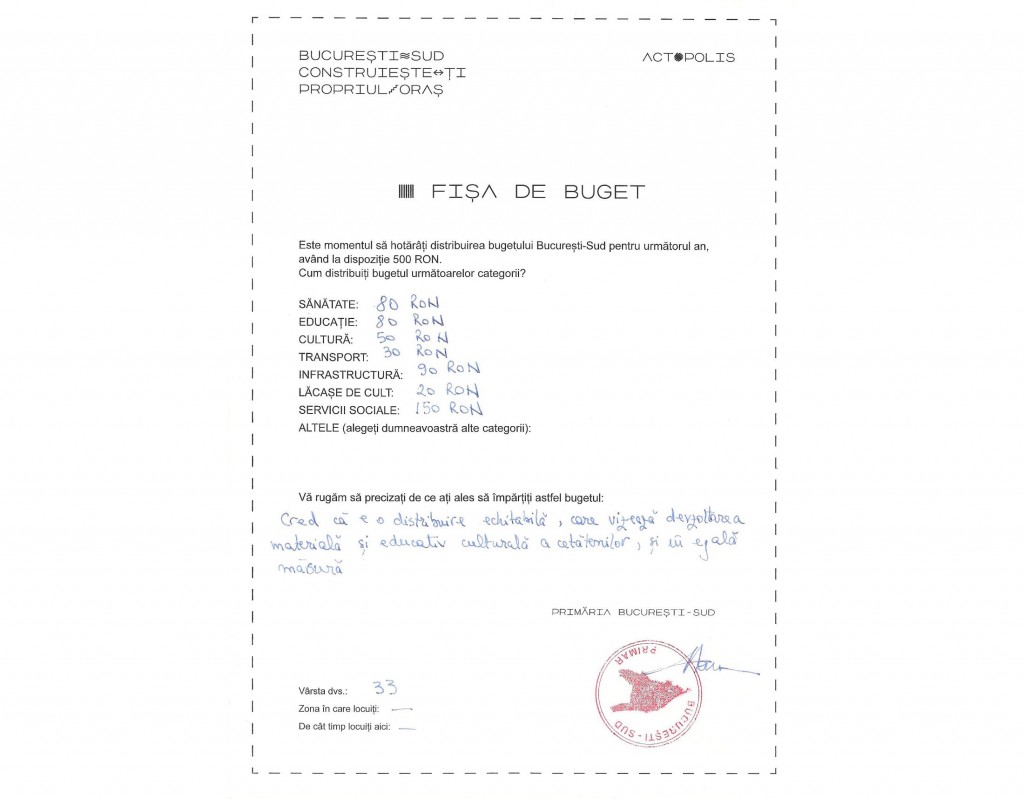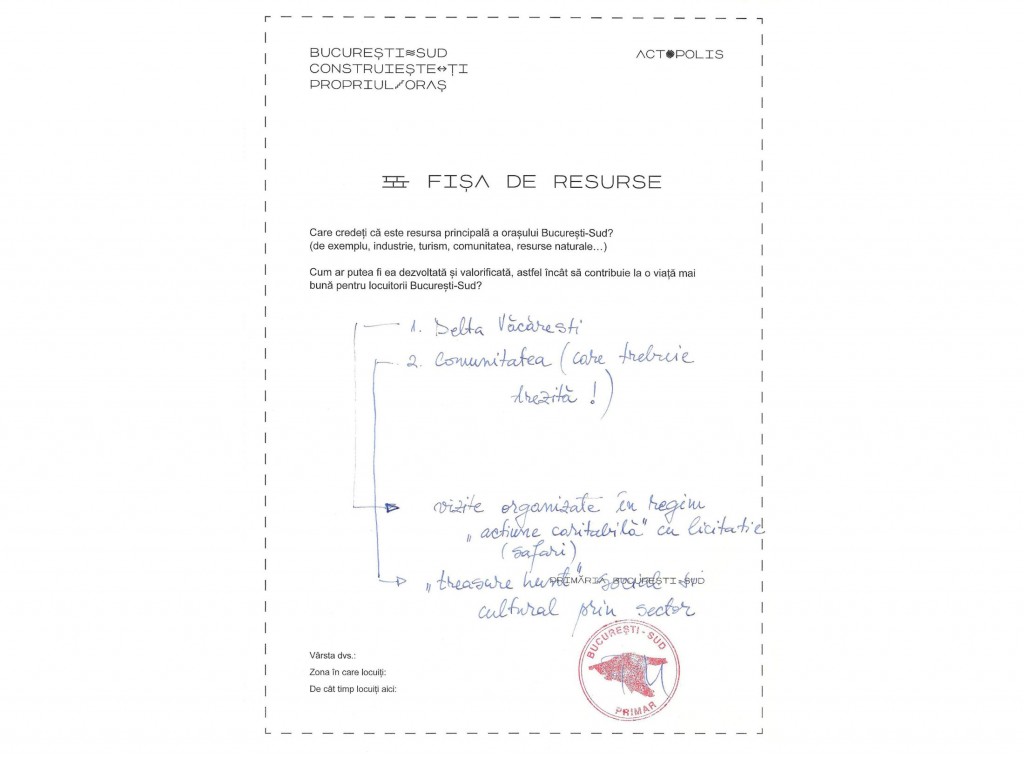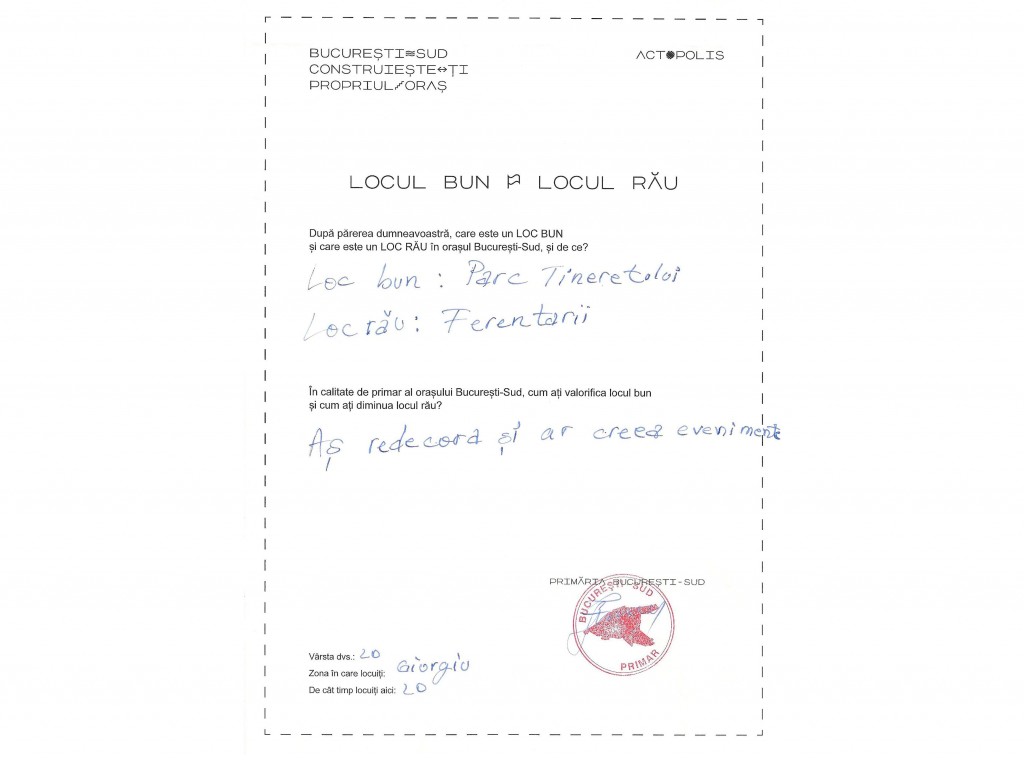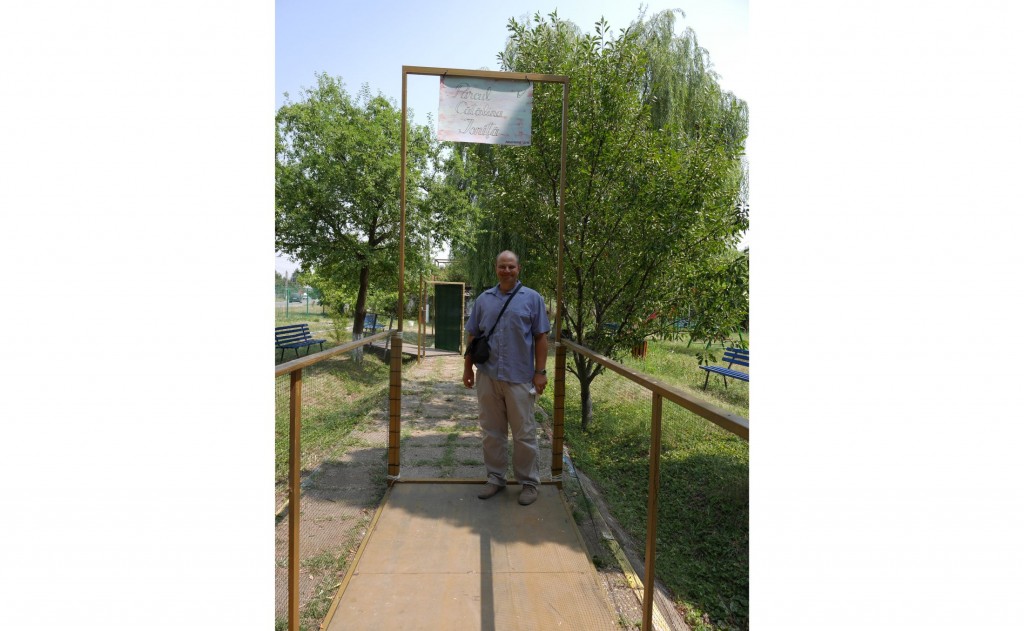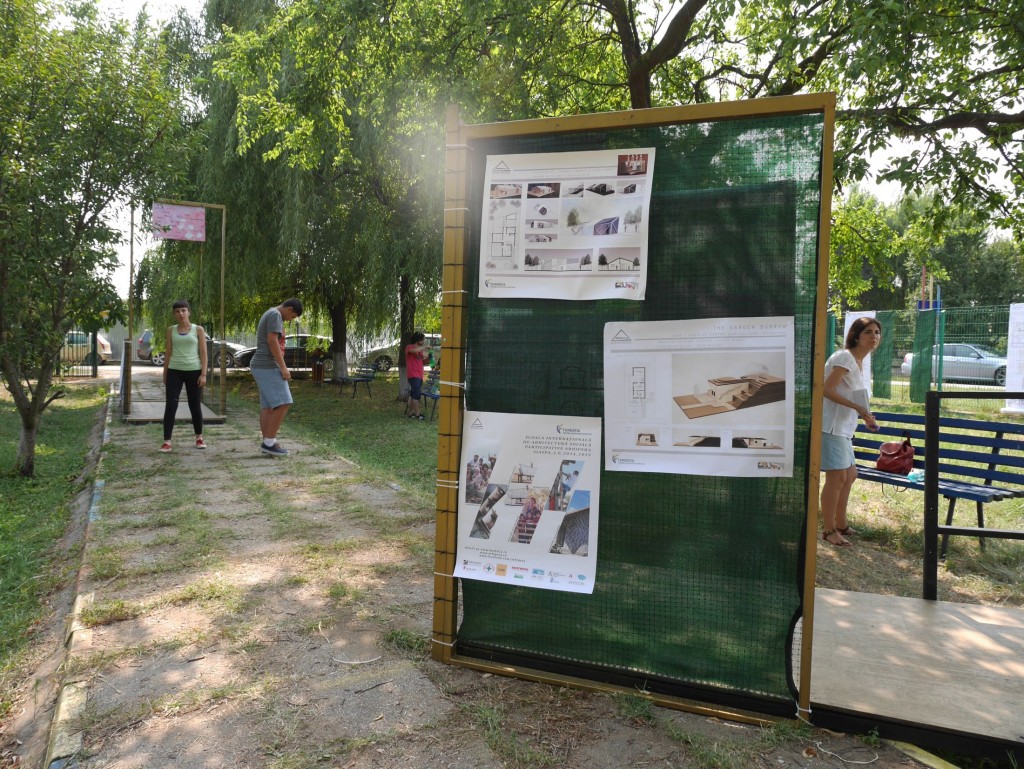In late May, nearly a hundred residents of the southern part of the city became, briefly, city mayors. In an exercise of imagination and responsibility, ideas and decisions came out of a mobile mayor’s office which moved in three districts in the area. We gathered the participants’ opinions and proposals and soon we will make them public. After completing the action, the pavilion was carried to Belciugatele village, Calarasi County, where Arhipera Association and a team of volunteers have reassembled it, as street furniture, in the park in the village centre.
Actopolis, Bucharest South. How it all started
A super‑program, for reflections and urban interventions, initiated and coordinated by Goethe‑Institut and Urbane Künste Ruhr, is taking place between 2015 and 2017. Actopolis. The Art of Action brings together artists, planners and activists from the main cities of South‑Eastern Europe and the Ruhr region in a joint production laboratory—yes, that very irksome part of Europe, as well as a German region that suffered enormously post de‑industrialization; places with huge problems, but also with a lot of creativity, courage and resourceful spirit. In fact, the range of the action and the scope of the project are not the countries, but the cities: Athens, Belgrade, Bucharest, Ankara/Mardin, Oberhausen, Sarajevo and Zagreb. The laboratory integrates interventions from each team and will
be completed by a travelling exhibition in 2017.
In Bucharest, Actopolis was organized by Goethe‑Institut, tranzit.ro/București and Zeppelin. Right from the beginning we decided not to cover the whole city, nor the obvious too popular neighbourhoods, such as the centre, and focus instead on the South. Not just because we know it, since tranzit.ro has its headquarters there and Zeppelin is developing the Carol Factory program in that area, but because this is a less privileged and ignored part of the city, a place that deserves so much to be brought into the light and be worked upon.
Like so many other facets of the eternal South, around the world, in Europe but also (partly) in Romania, the southern part of Bucharest is the underdog. There is a historical imbalance— the city grew northward (for reasons pertaining to wind, green areas, the road to Western Europe), successive good neighbourhoods are also there, while the south was populated by factories. Ceausescu’s urban operations, especially his colossal boulevard created a nearly impenetrable barrier, which has emphasized isolation in the past 26 years. Today, this area represents almost half the city, but has only 2 (!) museums, no embassy whatsoever, virtually no important building office, but it has instead shopping, many (and sometimes recognized as such) disadvantaged neighbourhoods, areas with major social and economic problems. It is, however, blessed with a lot of parks, former industrial areas where a lot of things can happen. In the past years, we started to see there more and more cultural independent spaces, social, civic and environmental initiatives (“Văcărești Delta”, the miraculous urban reserve, is also in the south), good things are slowly happening. And then there are some hundreds of thousands of citizens of all kinds, local cultures ignored or even despised, an energy worth taken into consideration.
Bucharest‑South. A different city
We started from a hypothetical story. If the South is just a blind spot for most Bucharest citizens, why not imagine it as a city itself? One that not only manages on its own but that also becomes a model of self‑organization, equity, and balanced development?
“Build your own city!” became the title of our project that goes on two main lines of action:
On the one hand, we are talking about a place and the people from that place, we bring to public attention the forgotten and little appreciated half of Bucharest. We have background stories—interviews about people and places, photo documentation, and even a mapping of its character and the good places (the previously mentioned independent initiatives).
On the other hand, we have built a participatory project, the subject of this article, which was the starting point of a documentary film that will be released this fall.
Mayors and their office. A participatory project
A self‑contained city obviously needs a mayor. In Romania today, mayors are elected, but involvement stops around there. Top‑down decisions are the rule, authority is opaque and often corrupt, civic spirit, especially locally, is weak, the lack of trust is sky high. We thought that a good civic exercise is to invite people to assume the role of mayor—to make a shift from needs, requests and complaints to decisions, accountability, responsibility; and with this, through decisions and opinions issued as mayors, to tell us something about their urban perceptions and dreams.
What would a mayor be without an office? So we made a mobile office, which we installed for one day in three different public spaces: in front of the former cinema Flamura, at the entrance in Sebastian Park and at Piața Sudului/South Market.
It was a symbolic office, a minimal structure, with platforms and transparent screens, but with everything in place: furniture design, precious golden colour, a map of the new city, an area for the mayor and one for discussions (the councilors’ area, we called it), floral decorations too… the whole nine yards.
It worked, attracting people. However, it must be said that although we carefully evaluated all the three places before, in a manner so typical of Bucharest, they changed quickly, with pop up kiosks, sudden construction sites and illegal advertising boards etc. Fortunately, the modular structure and flexible fixings allowed for three different aspects of what should have been a single office.
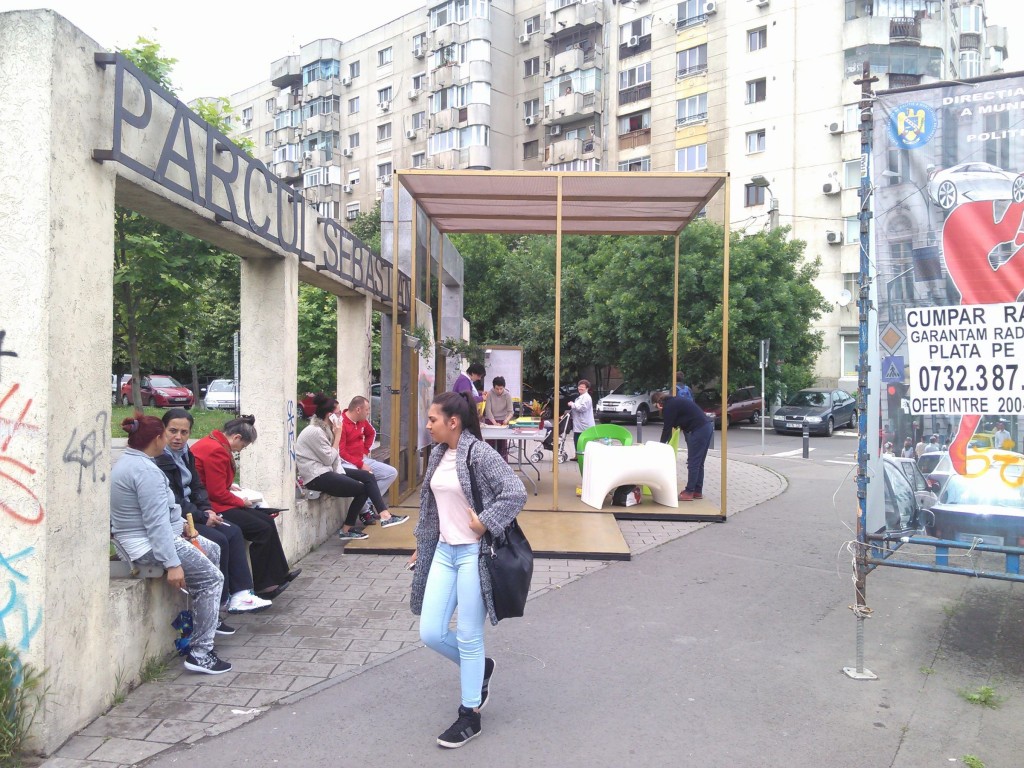
The mayors took an oath, received a sash, a stamp of the new city and paper forms—one to express their opinions and suggestions, another to divide a rough budget, and a diploma in the end.
It was an amazing experience to see how all kinds of people accepted the post, sceptical and/or laughing, and the ceremonial and all the tasks, then the sudden responsibility made them quickly take everything more seriously, to assume their part.
When instead of complaining you actually have to draft a budget, you know that if you add extra for the infrastructure, you take from education, and then you start thinking twice.
We had mayors of all kinds, some so enthusiastic that they were even trying as hard as they could not to leave the post, but on the whole, they were excellent. And some of them really moved us deeply.
What we learned from the mayors
The surveys, decisions and budgets served the game but were also aimed at finding out some opinions and aspirations of the citizens, about how they see their ideal but possible city. We did not get a rigorous result from a sociological point of view—we never even had this ambition—but a few conclusions can be drawn nonetheless (we have a detailed report on the website).
Mayoral dreams for the city of Bucharest‑South are not grand, but functional: more green areas and playgrounds, more organized traffic, special lanes and a tighter schedule for the public transport, maintenance work that won’t last for years, more work opportunities, cultural and artistic events, working social services, safety of residents and children, things which are natural for a city in 2016. The people did not choose the sci‑fi cities from the promises of the politicians, but realistic and necessary solutions, which meet the needs of the present: fresh air, tranquillity and respect.
Of course, the parks are good places par excellence, but there is also culture, even if they never mentioned the alternative, independent one, already situated in the south.
The mayor experience has led some to question even democracy and collaboration.In an e‑mail of thanks received from a participant, she writes: “I loved your project. It makes you meditate on things. Personally, I realized that a mayor can not make decisions by himself because it is not right to do so. The first thing I ought to have written on that paper was: to consult the citizens, to make up a team. The mayor is in the service of the community and must only act objectively”.
After the installation. The pavilion’s second life
What to do with our pavilion after finishing the art intervention? We came up with the idea to give it for free, but in a sensible way and with one condition: it had to be used for a social and/or cultural, strictly non‑commercial purpose only. A Facebook bid was organized and it went to Arhipera team, which for several years works on participative architecture (mainly housing) in rural areas subjected to extreme poverty (see the article in Zeppelin #143, september-november 2016 issue). They took our pavilion and turned into something very different –a public space refurbishment in a village near Bucharest.
Cătălina Ioniță Park, Belciugatele
TEXT: Diana Rizea, Teodora Lică, Sebastiaan Veldhuisen, Lorin Niculae
“We dedicated our intervention in Belciugatele to Cătălina Ioniță, whose reflections on significant empty space we share. Cătălina Ioniță Park is also a place for memory, and will, we hope, activate community through the exhibition function weproposed, by the places to contemplate nature and by favoring social relations. We hope it will last as Cătălina will continue to inspire us.” (Lorin Niculae)
Initially, as agreed by Lorin Niculae with the municipality of Belciugatele, Călărasi, we wanted to assemble the pavilion in the village park, close to the town hall. Soon we realized that things were a little more complicated. What would actually be the ideal location for the pavilion in the park? Who would be using it and for what purpose?
Our tutor, Sebastiaan Veldhuisen, architect from the Netherlands, proposed some techniques for analyzing the space by means of theatre exercises. So we became cats, or walked only on straight lines…this way, we discovered an area bordered by stones that must have been a flower bed, we found a toilet in the far right corner, and a water source. We discovered apple trees, and a nest of five storks on top of a lamppost across the street, the neighbors’ dogs, the small birds constantly being heard and a few cars passing by…
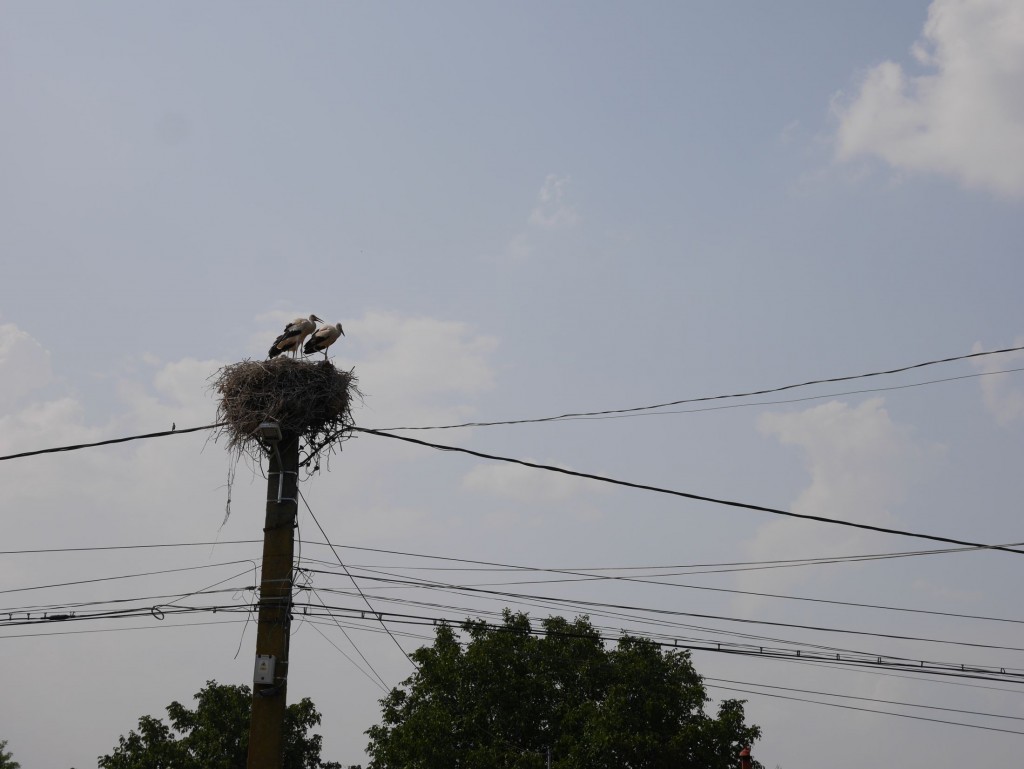
During the day the park was hardly used—a few children playing on the swings and the slide and an old maneach day resting for a while on the bench closest to the entrance. In the evening, we found a group of around 20 teenagers drinking and having fun and they told us the park was the only place for gathering in this village.
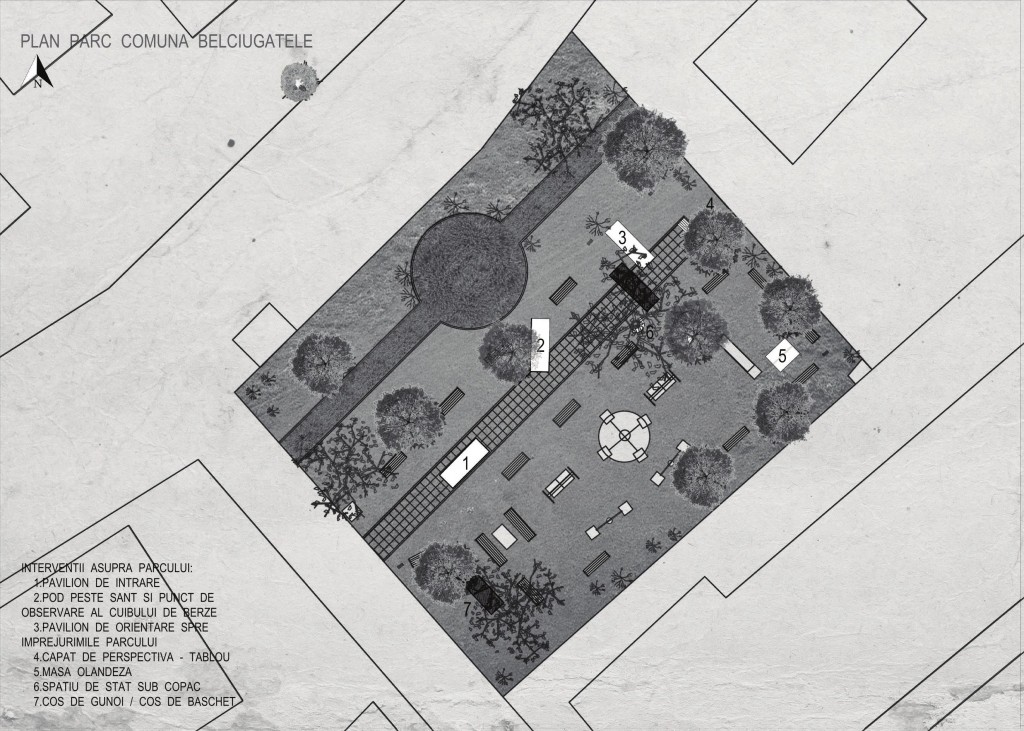
Although we had good ideas to start, we found that essential parts were missing, and we lacked the right tools and means of fixing the frames together. Therefore, we decided to use the parts to construct several follies to mark specific point of attention in the park; a humble reference to Parc de la Villette in Paris.
A 3,70 m. high frame forms a portal to invite you in and to encourage you to halt and look at the sky between the trees. The second lower frame carries you from the scale of the surrounding houses to the scale of the park. The third one frames a tree like a real painting. From here a floor board changes the direction and serves as a bridge over one of the two ditches aligning the path. The railing on one side invites to lean on it and to admire the stork nest which is best spotted from here. The third folly crosses the path to give it a proper ending. We imagine this one could be used to play a game of chess. It also frames apainting at the end of the path with one of the Goethe’s quotes in Romanian saying: ’’Nature is the only book of which every page contains deep significance’’. Arriving at the unused far corner of the park, we built a bar height table to give the youth an alternative place further away from the complaining neighbors! The last object we made is the most practical one: a huge trash bin for plastic bottles, as the provided bins in the park are wrongly placed and too small.
On the final day more people came to the park and were interested in the new constructions. A few days after we finished we received a message that villagers were planting flowers in the park. Somehow we managed to make a change; to give the park a new quality, a quality acknowledged by the users, cultural and symbolic.
Credits
Curators: Raluca Voinea, (tranzit.ro/București); Ștefan Ghenciulescu, (Asociaţia Zeppelin)
Art instllation (concept, design): Daniela Pălimariu, Constantin Goagea
Coorodnator of the research on Bucharest-South: Cosmina Goagea
Bucharest-South Stories: Mihai Duţescu
Program of the installation, social research: Iuliana Dumitru, sociolog
Documentary movie: Vlad Petri
Goethe-Institut team: Evelin Hust, director; Oana Lăpădatu, coordinator of the Cultural programs / Music and Visual Arts program
Colaborators: Matei Popescu, Sorina Dumitru, construction; Dragoș Dragnea, design; Claudiu Forgaci, Maria Constantinescu, research
Operators of the installation: Floriana Genes, Bogdan Stănescu, Sorin Popescu
www.e-zeppelin.ro, www.tranzit.org
Actopolis. The Art of Action
Organizers: Goethe-Institut, Urbane Künste Ruhr.
Artistic direction: Angelika Fitz, Katja Aßmann, Martin Fritz
http://blog.goethe.de/actopolis/
„Cătălina Ioniță”Park
The team:
Diana Laura Rizea, Teodora Lică, Alexandra Maxim, Alexandru Brătescu, Alexandru Popa, Sebastian Veldhuisen, with help from: Diana Costache, Ionuț Paraschiv, Andrei Ardeleanu and Ștefania Simu.
Coordination: Lorin Niculae
Thanks to: Cătălin Caragea, Andrei Stroe, Andrei Coman, Gheorghe Percu
25. -30.07. 2016, 5th Arhipera summer school
www.arhipera.ro

